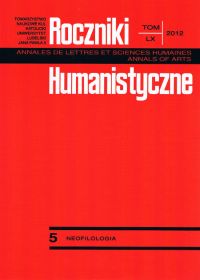Predicational, Specificational, Equative and Identificational Copular Clauses in English and Polish
Abstract
The paper confronts the typology of copular sentences proposed by Higgins (1979) for English with the Polish data. Higgins distinguishes in English four types of copular sentences, such as predicational, specificational, equative and identificational. The paper shows that these four types of sentences are also present in Polish although their inventory is much bigger than in English because, in addition to the verbal copula, Polish also has a pronominal copula to, and even shows the co-occurrence of these two elements in the same clause (the so-called dual copula sentences). All these three types of copula sentences may have a predicational function, but the remaining three functions can only be associated with the clauses containing to or those with both to and być. The paper presents examples of ambiguous sentences and the tests to eliminate the ambiguity. An attempt has also been made to reduce Higgins’ typology. It has been shown that Polish inverted equative sentences show properties typical of specificational sentences. As for identity statements, arguments have been provided in favour of the claim that both in English and in Polish they can be classified as either specificational or equative.
References
Adger, D. and G. Ramchand. 2003. Predication and equation. Linguistic Inquiry 34(3): 325-359.
Akmajian, A. 1979. Aspects of the grammar of focus in English. New York: Garland.
Błaszczak, J. and L. Geist. 2000a. Zur Rolle des Pronomens to/ėto in spezifizierenden Kopulakontruktionen im Polnischen und Russischen. In G. Zybatow, U. Junghanns, U. Mehlhorn, and L. Szucsich (eds.) Current Issues in Formal Slavic Linguistics (Linguistik Intenational 5). 247-257. Frankfurt am Main: Peter Lang.
Błaszczak, J. and L. Geist. 2000b. Kopulasätze mit den pronominalen Elementen to/ėto im Polnischen und Russischen. In E. Lang (ed.) Copular and AUX – Constructions. ZAS Papers in Linguistics 16: 115-139. Berlin: ZAS.
Citko, B. 2008. Small clauses reconsidered: Not so small and not all alike. Lingua 118: 261-295.
Declerck, R. 1988. Studies on copular sentences, clefts and pseudoclefts. Dordrecht: Leuven University Press and Foris.
den Dikken, M. 2006. Relators as linkers The syntax of predication, predicate inversion and copulas. (Linguistic Inquiry Monographs). Cambridge, Mass.: MIT Press.
Heycock, C. and A. Kroch. 1999. Pseudocleft connectedness: Implications for the LF interface level. Linguistic Inquiry 30(3): 365-397.
Higgins, R.F. 1979. The pseudo-cleft construction in English. New York: Garland.
Mikkelsen, L. 2005. Copular clauses. Specification, predication and equation. Amsterdam and Philadephia: John Benjamins.
Mikkelsen, L. 2006. Specificational copular sentences. Paper presented in Kobe Area Circle of Linguistics, Kobe Shoin Women’s University, November 2006.
Mikkelsen, L. 2011. Copular clauses. In K. von Heusinger, C. Meienborn and P. Portner (eds.) Semantics: An International Handbook of Natural Language Meaning. Berlin: Mouton de Gruyter.
Moro, A. 1997. The raising of predicates: Predicative noun phrases and the theory of clause structure. Cambridge: Cambridge University Press.
Partee, B. 1998. Copula inversion puzzles in English and Russian. In K. Dziwirek, H. Coats and C. Vakareliyska (eds.) Formal Approaches to Slavic Linguistics: The Seattle Meeting 1998. 361-395. Ann Arbor: Michigan Slavic Publications.
Partee, B. 2010. Specificational copular sentences in Russian and English. In A. Grønn and J. Marijanovic (eds.) Russian in Contrast, Oslo Studies in Language 2(1): 25-49.
Pereltsvaig, A. 2001. On the nature of intra-clausal relations. Doctoral dissertation, Montreal, McGill University.
Rothstein, S. 2001. Predicates and their subjects. Dordrecht: Kluwer.
Williams, E. 1983. Semantic vs. syntactic categories. Linguistics and Philosophy 6(3): 423-446.
Copyright (c) 2012 Roczniki Humanistyczne

This work is licensed under a Creative Commons Attribution-NonCommercial-NoDerivatives 4.0 International License.





